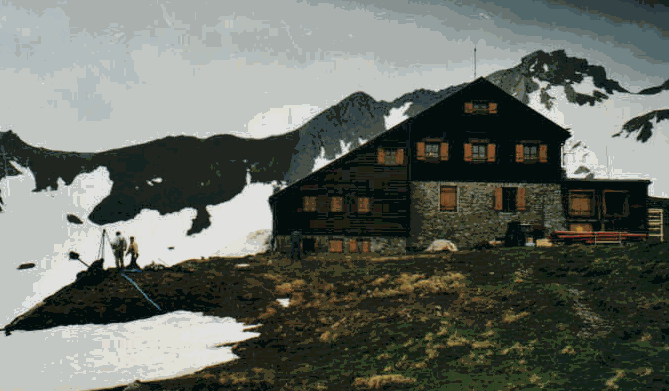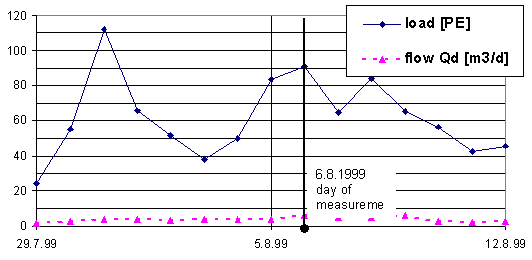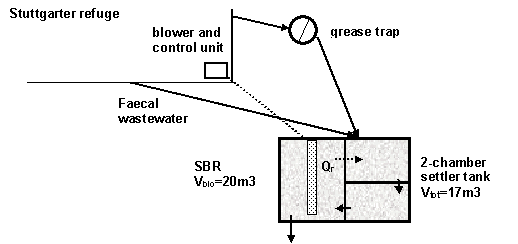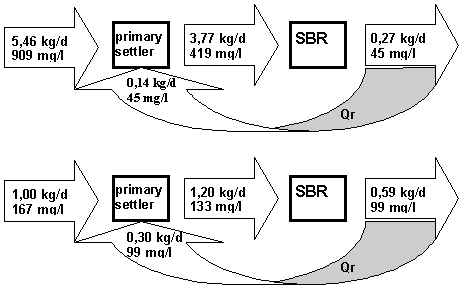environmental benefit of wastewater treatment plants in mountainous areas in the alps

|
Comparison of technology, costs and environmental benefit of wastewater treatment plants in mountainous areas in the alps |

|
Abstract
Keywords
Problem description
Load calculation
Mass balances
Conclusion
Acknowledgement
References
The influent flow concentrations of a small wastewater treatment plant are certainly difficult to measure. Extreme variations of the raw wastewater characteristics and waste sludge and recycle flow from the biological stage to the primary settler can prevent representative sampling. The calculation of the total daily influent load from specific empirical loads and its confirmation by mass balances can solve this problem. Balancing the mass transport by the influent, the effluent and internal flows opens a telling view on the actual situation in a small WWTP and allows an evaluation of the performance of the treatment plant.
Small WWTP, mountains, mass balance, evaluation, wastewater characterisation

Fig. 1: View of the Stuttgart refuge and its WWTP (subterranean SBR on the left hand side)
There are two possibilities to quantify the performance of a WWTP – by a declaration of the treatment efficiency or the effluent concentrations. Mostly water quality authorities proclaim both criteria in order to obtain effluent standards which are not affected by local characteristics of the raw wastewater or by dilution effects. In Austria a separate emission decree regulates the treatment efficiency of small WWTPs in mountainous areas. This category of treatment plants has to meet an efficiency of at least 70 % according to the daily COD load and 80 % according to the BOD load. To calculate the treatment efficiency both values of the influent and the effluent concentrations of the organic matter are required. But especially at small WWTPs with short sewers the raw wastewater is very inhomogeneous and the concentrations show extreme variations. The practician´s problem to tackle is to get a representative sample from the influent flow. A sample of clarified wastewater from the primary settler or septic tank under the consideration of the settleable organic matter could give an acceptable approximation. But waste sludge flow or recycled effluent flow from the biological stage fed to the primary settler affect the measured concentrations. An additional problem occurs with marked load variations (Wett et al., 1999) and high hydraulic retention times. In this case the effluent values correlate not only with influent values of the actual day of measurement but also with loads of previous days.
For small WWTPs with difficulties in obtaining representative influent samples a calculation of the influent load instead of measurement can be suggested. The wastewater loads of tourist facilities depend on the standard of the water supply, sanitary equipment and the kitchen. Correct load calculations require detailed data about frequency and duration of visits. In fig.2 the empirical relation between the duration of visits and the emitted organic load is given (ÖWAV, 2000). The calculated load together with the measured daily water consumption results in the daily average influent concentration. An example for an influent load calculation is shown (fig.3) and verified by measurements in the treatment plant and by mass balances.
sanitary equipment
poor
average
good
permanent inhabitant
overnight guest
daily guest / brief visit
daily guest / extended visit
25 + 30
25 + 25
10 + 10
5 + 10
60
55 - 60
15 - 20
10 - 15
60 - 75
60 - 90
15 - 20
10 - 15
In Austria usually a load of 60g BOD, 100 to 200g COD and 10 to 12 g N per dey and PE is assumed. In houses with poor sanitary equipment (e.g. no water toilet) the first load value represents the flow off load and the second value the load restrained in the dry toilet or composting toilet (particulare matter).
Fig. 2: Excerpt from table 3 of the Guideline 1 ("Wastewater treatment in mountainous areas") published by the Austrian Water and Waste Management Association (ÖWAV, 2000) concerning the specific organic loads of different users of tourist facilities in the Alps at different sanitary standards.

Fig. 3: Variations of load and flow at the Stuttgart refuge WWTP during a two weeks period
At the Stuttgart refuge at 2310 m a.s.l. (fig.1) a generously designed 3-chamber septic tank has been upgraded to a biological WWTP. Within the largest chamber devices for an SBR-operation have been installed and the two smaller chambers are still used as primary settlers (fig.4). From counted 55 overnight guests, 150 daily guests and 8 persons staff during the 6.8.1999 a loading of 91 PE has been calculated as demonstrated above. Measurements revealed a water consumption of 6,0 m3/d and effluent concentrations of 45 mg BOD/l and 99 mg Ntot/l. A commonly assumed treatment efficiency of the primary settler of 1 third according to BOD and 10 % according to Ntot was considered (ATV A-131, 1991), which is applicable only at the beginning of the seasonal operation. In case primary and secondary sludge is stored in the septic tank, the treatment efficiency decreases reasonably (organic matter about 25 % efficiency, nitrogen about 5 %) throughout the season due to resolution of organic matter and ammonia.
Specific water consumtion: Qd,PE = 66 l/PE/d
Organic influent concentration WWTP: BODin = 60.000 mg BOD/PE/d / 66 l = 909 mg BOD/l
Nin = 11.000 / 66 = 167 mg Ntot/l
Efficiency of primary settling: BODdecant = 909 * 2 / 3 = 606 mg BOD/l
Ndecant = 0,9 * 167 = 150 mg Ntot/l
Dilution effect due to recycling Qr = ca.3 m3/d; BODef = 45 mg BOD/l
BODbio = (3 * 45 + 6 * 606) / 9 = 419 mg BOD/l
Nbio = (3 * 99 + 6 * 150) / 9 = 133 mg Ntot/l

Fig. 4: Flowscheme of the small WWTP of the Stuttgart refuge

Fig. 5: Carbon and nitrogen balance at the WWTP of the Stuttgart refuge (6.8.1999)
The loading at the day of measurement (91 PE) is higher than the days before (3-days average 57 PE). But the increased influent concentrations have been equalized in the primary settler with an hydraulic retention time of more than 2 days. Out of this reason the measured concentration in the primary settler (320 mg BOD/l) is lower than the calculated value (419 mg BOD/l). The total treatment efficiency of the WWTP at the considered day achieved 95 % according to BOD and 41 % according to total nitrogen and therefore met the legal requirements. A low sludge concentration in the SBR (0,73 g MLSS/l) respectively a high sludge loading (F/M ratio 0,26 kg BOD/kg TSS) was responsible for the poor nitrification performance.
A detailed documentation of the amount of guests and water consumption during the previous days is the base for a sufficient survey on the load situation of a small WWTP and the calculation of a mass balance. Concentration values obtained from grap samples of the effluent flow of the septic tank and the biological treatment close the mass balance respectively confirm it. Mass balances applied on different types of small WWTPs (SBR and trickling filter) in the Alps have validated load calculations from empirical specific loads. Specific loads depending on the category of sanitary standard and guests and the state of the art in wastewater treatment in extreme mountainous environments are outlined in a guideline (ÖWAV, 2000).
The results of this presentation are achieved within the project "Comparison of technology, costs and environmental benefit of wastewater treatment plants in mountainous areas in the Alps", which is supported by the LIFE-program of the European Commission.
ÖWAV (Austrian Water and Waste Management Association), 2000: Wastewater treatment in mountainous areas (in German, English, French and Italian). Guideline 1, Vienna
ATV (wastewater technology Association), 1991: Design of one-stage activated sludge systems (>5000 PE). Guideline A131, Hennef
Wett, B., Becker, W., Ingerle, K., 1999: Load-flexibility of small activated sludge systems. Proc. 4th IAWQ Spec.Conf.on Small WWTPs, Stratford-upon-Avon